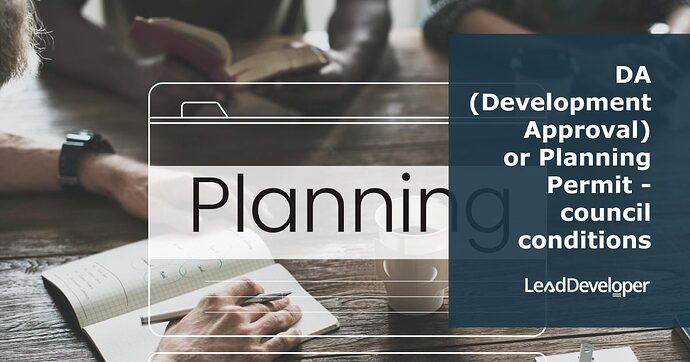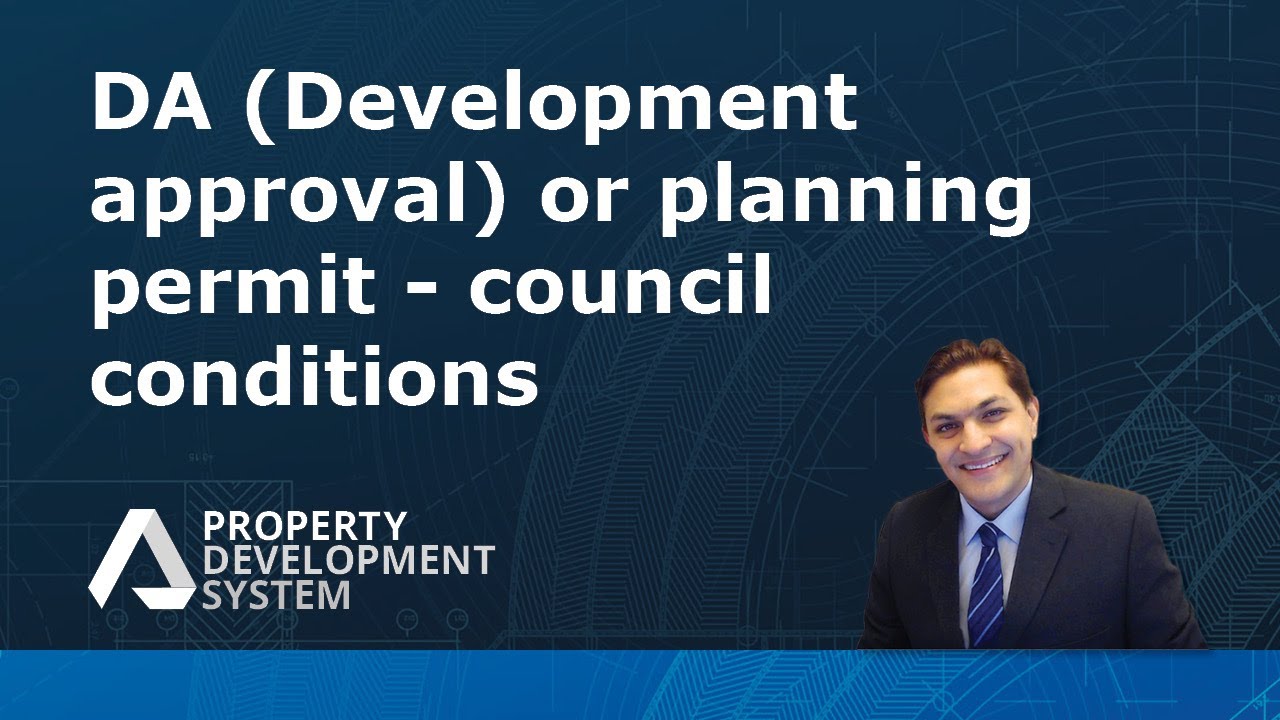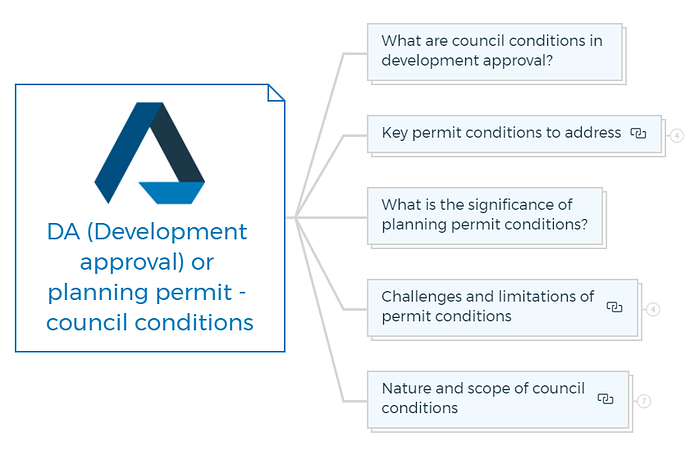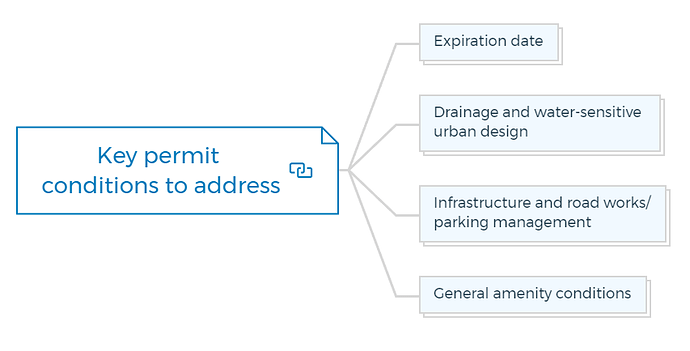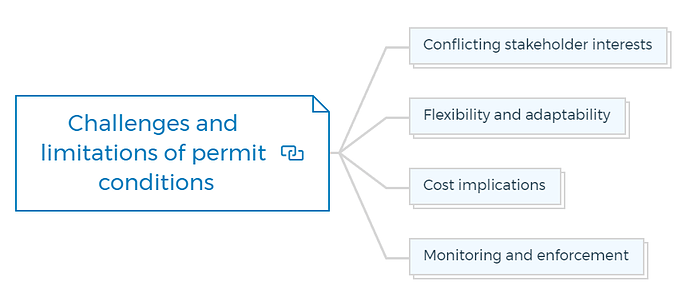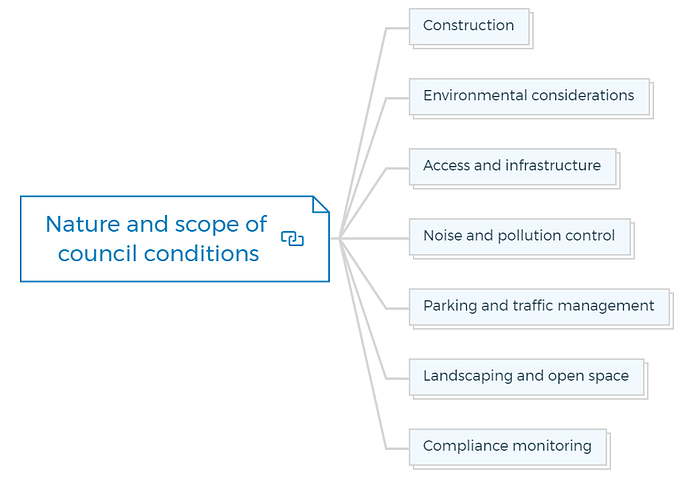DA Process - Permit Conditions
What are council conditions in development approval?
The conditions imposed by a local council or municipality when approving a development proposal are called council conditions. Council conditions ensure that the development follows legislation, protects the environment, and mitigates community consequences.
Conditions of development approval specify how the development is to be carried out, usually to protect or reduce impacts on the environment and amenities of the surrounding area and to ensure that all necessary civic infrastructure adequately services the proposed development.
Permit conditions generally consist of an action to be carried out and the timing for that action to be undertaken if neither reasonable nor relevant, conditions may be changed or removed.
You are missing out if you haven’t yet subscribed to our YouTube channel.
Key permit conditions to address
Before the development commences, carefully check all the details and terms and conditions compiled in the permit.
The permit may be granted with some amendments in the planning, or some tweaking is required to the physical aspects of the site.
A condition could require a landscape plan to be prepared and submitted to the council for approval. You can’t work with the permit until all the specifications mentioned along with the permit are met and complied with.
Whether it’s just a variation that requires approval from the council, make sure the council endorses your plans. Below mentioned are some of the permit conditions that must be catered in time:
Expiration date
Most of the permits expire within a two years time period of their issuance. However, specified times might be included as the permission of the permit.
Make sure to check for any time extensions (if there are any).
Look for costs involved, landscape plans or any other amendments required to the existing plan.
The provision of the landscape plan and associated planting schedule for the site showing the proposed location, species type, mature height and width, pot sizes and the number of species required to be planted on the site must be prepared by a landscape professional.
Drainage and water-sensitive urban design
While considering this aspect of the permit conditions, you may need to look for the following:
- Provision for rainwater tanks or solar hot water service
- Provision for stormwater works, which incorporates the use of water-sensitive urban design principles to improve stormwater runoff
- Provision of splay
- Stormwater management plan.
Infrastructure and road works/parking management
Check the permit thoroughly if it requires any specific changes to the parking space or the attributes related to infrastructure causing any hindrance in traffic management, such as:
- Relocation of pits/Power Poles
- Tree Removals
General amenity conditions
People often skip this point while considering planning permits. This can be one of the biggest hindrances in the development process if they are addressed or addressed.
For instance, heating and cooling units and exhaust fans must not be located adjacent to bedroom windows on adjoining properties. They must be concealed from the street - or you must have written consent from the authority.
What is the significance of planning permit conditions?
Council conditions ensure responsible and sustainable development. They balance development goals with community and environmental protection.
These factors shape the project’s design, construction, and operation to meet local planning goals.
Challenges and limitations of permit conditions
Council conditions for development approval help guide and regulate development initiatives. However, there are certain obstacles and constraints.
Understanding these issues can help property developers and local councils find better solutions.
Here are some common challenges and limitations:
Conflicting stakeholder interests
Developers, residents, business owners, and community groups may have opposing interests and agendas. Balancing these perspectives and reaching a consensus on council conditions requires substantial consultation and negotiation.
Flexibility and adaptability
Council conditions or permit conditions are usually based on available information. However, as projects proceed, unforeseen circumstances or market conditions may need alterations. Maintaining conformity while allowing for modifications is difficult.
Cost implications
Council conditions like infrastructure upgrades or additional amenities can drastically boost development project costs.
This poses challenges for developers, particularly for smaller-scale projects or when budgets are constrained. Councils must balance community demands with economic feasibility.
Monitoring and enforcement
Council conditions must be monitored and enforced. Councils may have resource constraints while inspecting and enforcing authorised plans and conditions. Accountability requires improving monitoring and enforcement.
Nature and scope of council conditions
Council conditions encompass a wide range of considerations tailored to the specific project and its surroundings. Some common areas covered by these conditions include:
Construction
To ensure safety and quality, councils set requirements for materials, construction procedures, and project timeframes.
Environmental considerations
It includes erosion control, vegetation preservation, stormwater management, and wildlife conservation.
Access and infrastructure
Developments may require developers to upgrade or build new infrastructure to handle transportation, utilities, and public services.
Noise and pollution control
Construction and operational noise, dust, and other pollution are reduced to minimise community disturbance.
Parking and traffic management
Parking, traffic management plans, and road access improvements mitigate traffic impacts.
Landscaping and open space
Developers may be required to include landscaping plans, open areas, or recreational facilities to improve aesthetics and community well-being.
Compliance monitoring
Councils may mandate regular inspections and reporting to guarantee compliance with authorised plans and conditions.
Test Your Knowledge
Practical Exercise: Understanding Council Conditions in Development Approval
Objective:
This assignment aims to deepen your understanding of the role and impact of council conditions in the development approval process. Through a series of questions, research tasks, and practical exercises, you will explore how these conditions influence sustainable and responsible development within a community.
Part 1: Questions for Understanding
Define Council Conditions
What are council conditions, and why are they important in the development approval process?
Impact of Council Conditions
How do council conditions aim to protect the environment and mitigate community consequences?
Key Permit Conditions
Identify and explain at least three key permit conditions that developers must address before commencing development.
Significance of Planning Permit Conditions
Discuss the significance of planning permit conditions in ensuring responsible and sustainable development.
Challenges and Limitations
What are some common challenges and limitations associated with permit conditions from the perspective of developers and local councils?
Part 2: To Do’s
Case Study Analysis
Find a recent development project in your area that has gone through the council approval process. Summarize the council conditions applied to the project and how they affected its outcome.
Role-Play Activity
In groups, simulate a council meeting where one group represents the local council, another the developers, and another the community. Discuss proposed development and negotiate conditions to balance all interests.
Design a Landscape Plan
Based on the provided requirements for a hypothetical development project, design a simple landscape plan. Ensure to include the proposed location, species type, mature height and width, pot sizes, and the number of species required.
Part 3: Research Questions
- Comparative Analysis: Research and compare the council conditions for development approval in two different municipalities. What similarities and differences do you find?
- Economic Impact: Investigate the economic implications of council conditions on a development project. Provide examples where additional conditions have significantly increased project costs.
- Innovative Solutions: Explore and report on innovative solutions or approaches that have been used to overcome challenges associated with council conditions, such as conflicts between stakeholders or cost implications.
- Global Perspectives: Examine how other countries handle development approval and council conditions. Identify any unique approaches or practices that could be beneficial in your local context.
Submission Guidelines:
- Format: Responses should be submitted in a report format, clearly divided into the three parts outlined above.
- Length: The total length of the report should not exceed 15 pages, including any diagrams or appendices.
- References: All sources of information must be appropriately cited, following the citation style preferred by your instructor.
Assessment Criteria:
- Depth of Understanding: Demonstrates a thorough understanding of council conditions and their significance in the development approval process.
- Analytical Skills: Effectively analyses case studies and compares different scenarios or municipalities.
- Creativity: Shows creativity in the landscape plan design and in proposing innovative solutions to challenges.
- Clarity and Organization: Presents information clearly and logically, with a well-structured report.
